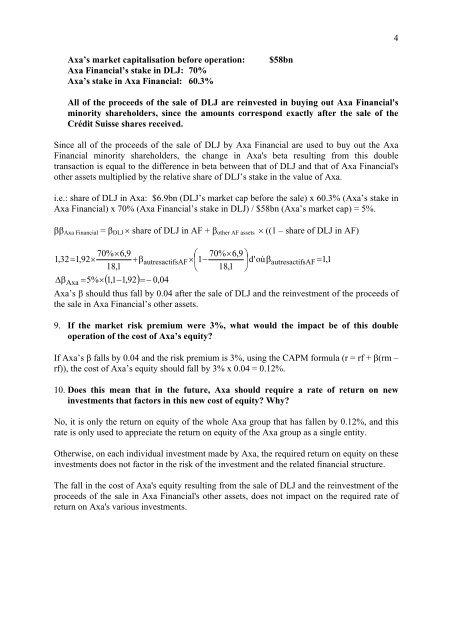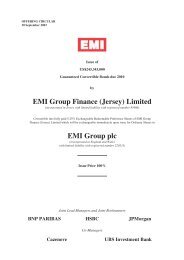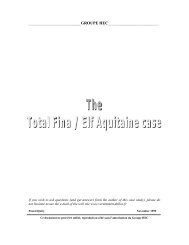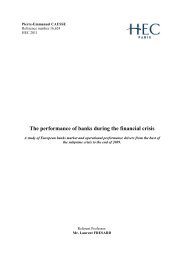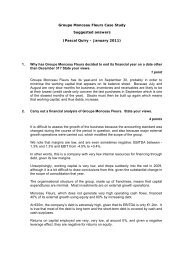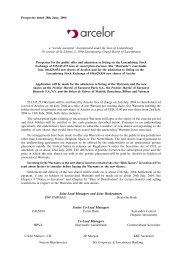Axa Financial case study - Vernimmen
Axa Financial case study - Vernimmen
Axa Financial case study - Vernimmen
Create successful ePaper yourself
Turn your PDF publications into a flip-book with our unique Google optimized e-Paper software.
4<br />
<strong>Axa</strong>’s market capitalisation before operation:<br />
<strong>Axa</strong> <strong>Financial</strong>’s stake in DLJ: 70%<br />
<strong>Axa</strong>’s stake in <strong>Axa</strong> <strong>Financial</strong>: 60.3%<br />
$58bn<br />
All of the proceeds of the sale of DLJ are reinvested in buying out <strong>Axa</strong> <strong>Financial</strong>'s<br />
minority shareholders, since the amounts correspond exactly after the sale of the<br />
Crédit Suisse shares received.<br />
Since all of the proceeds of the sale of DLJ by <strong>Axa</strong> <strong>Financial</strong> are used to buy out the <strong>Axa</strong><br />
<strong>Financial</strong> minority shareholders, the change in <strong>Axa</strong>'s beta resulting from this double<br />
transaction is equal to the difference in beta between that of DLJ and that of <strong>Axa</strong> <strong>Financial</strong>'s<br />
other assets multiplied by the relative share of DLJ’s stake in the value of <strong>Axa</strong>.<br />
i.e.: share of DLJ in <strong>Axa</strong>: $6.9bn (DLJ’s market cap before the sale) x 60.3% (<strong>Axa</strong>’s stake in<br />
<strong>Axa</strong> <strong>Financial</strong>) x 70% (<strong>Axa</strong> <strong>Financial</strong>’s stake in DLJ) / $58bn (<strong>Axa</strong>’s market cap) = 5%.<br />
ββ <strong>Axa</strong> <strong>Financial</strong> = β DLJ × share of DLJ in AF + β other AF assets × ((1 – share of DLJ in AF)<br />
70% × 6,9<br />
⎛ 70% × 6,9 ⎞<br />
1,32=<br />
1,92×<br />
+βautresacti fsAF×<br />
⎜1−<br />
⎟d'oùβautresactifsAF<br />
= 1,1<br />
18,1<br />
⎝ 18,1 ⎠<br />
∆ β<strong>Axa</strong><br />
= 5% × ( 1,1 −1,92) = − 0, 04<br />
<strong>Axa</strong>’s β should thus fall by 0.04 after the sale of DLJ and the reinvestment of the proceeds of<br />
the sale in <strong>Axa</strong> <strong>Financial</strong>’s other assets.<br />
9. If the market risk premium were 3%, what would the impact be of this double<br />
operation of the cost of <strong>Axa</strong>’s equity<br />
If <strong>Axa</strong>’s β falls by 0.04 and the risk premium is 3%, using the CAPM formula (r = rf + β(rm –<br />
rf)), the cost of <strong>Axa</strong>’s equity should fall by 3% x 0.04 = 0.12%.<br />
10. Does this mean that in the future, <strong>Axa</strong> should require a rate of return on new<br />
investments that factors in this new cost of equity Why<br />
No, it is only the return on equity of the whole <strong>Axa</strong> group that has fallen by 0.12%, and this<br />
rate is only used to appreciate the return on equity of the <strong>Axa</strong> group as a single entity.<br />
Otherwise, on each individual investment made by <strong>Axa</strong>, the required return on equity on these<br />
investments does not factor in the risk of the investment and the related financial structure.<br />
The fall in the cost of <strong>Axa</strong>'s equity resulting from the sale of DLJ and the reinvestment of the<br />
proceeds of the sale in <strong>Axa</strong> <strong>Financial</strong>'s other assets, does not impact on the required rate of<br />
return on <strong>Axa</strong>'s various investments.


